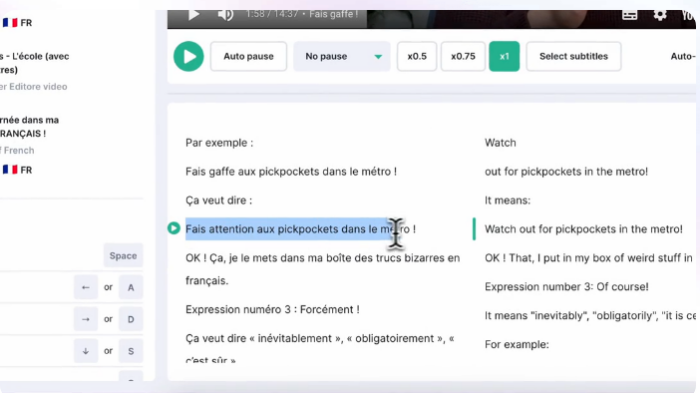How to Go From Intermediate to Advanced Language Level
Read other articles:
Back to posts
Table of Contents
Have you hit a foreign language roadblock?
Were you making great strides with your language learning at the beginning only to hit a brick wall?
Rest assured, many second language learners who aim to master a foreign language to a native speaker level experience these challenges as they develop proficiency.
Often, they “plateau out” and become demotivated, unable to engage with others to the required level, pausing for too long, using the same phrases repeatedly or scratching around for words that they feel should come naturally.
To continue your journey toward the native speaker level, you need to deepen and extend your knowledge and use of the language. This usually requires some new inspiration, as well as dedication and maybe a new approach that takes you outside your learning comfort zone a little.
Let’s take a closer look at how you can go from intermediate to advanced level…
Beginner, intermediate and advanced levels
It generally takes a long time to learn a language. Whether you’re trying to learn one of the easiest languages or most difficult languages in the world, you’ll likely progress through a series of recognizable stages during your journey. It’s not going to happen in a month.
Let’s keep it simple and call the different language proficiency levels Beginner, Intermediate, and Advanced. Above Advanced, we might have Superior or Native-Speaker level.
Most people are familiar with these terms although language centers may use either the CEFR or ACTFL system to assess the proficiency levels of students.

- The CEFR language levels: A1 & A2 (Basic), B1 & B2 (Independent) and C1 & C2 (Proficient).
- The ACTFL language levels: Novice, Intermediate, Advanced, Superior, and Distinguished.
If you’re aiming to progress from an intermediate to an advanced level of language proficiency, you essentially want to go from here…
- Communicating about and understanding the main points of a variety of topics
- Offering basic explanations and opinions
- Describing experiences, hopes, etc.
- Producing language on familiar and interesting topics without pausing to rephrase or consider expressions too much
- Achieving moderate fluency
- Making errors relatively frequently with more advanced topics
….to here:
- Using and understanding language on topics that are less familiar or more abstract
- Using language fluently for long periods without pausing
- Participating in conceptually difficult conversations
- Using language more spontaneously
- Adjusting language use appropriately for different styles and audiences
- Understanding highly stylized, idiomatic or colloquial language
- Beginning to think in the target language
- Rarely making errors
- Using regular, native-speaker pacing
So, how do we do that effectively?
Six ways to go from intermediate to advanced level
Try adopting some (or all) of the following strategies to get you closer to the native-speaker level:
1. Language immersion
Surround yourself with the target language to absorb it more naturally. This can mean many things but, most importantly, exposure to the language outside of a more formal learning environment—whether that’s a traditional classroom, online language lessons with a tutor or an online course.

Combining immersion in the language and making it entertaining will increase engagement with the natural rhythms and expressions of the language, while also building vocabulary and keeping things interesting.
That could mean watching TV shows, reading comic books or newspapers, playing online games or listening to songs or another activity in your target language. This will improve your listening and reading skills passively as well as actively.
For most learners, it’s easier to achieve language immersion online than through real people you interact with—though of course, the latter is even more effective if available to you.
The beauty of online learning is that you can immerse yourself in the language on your way to work or school, during lunchtime or at almost any other points during the day.
For true immersion, think of it less like learning a language and more like “changing your life” to your target language! Do as much as you can in your second language. You might start by changing your phone language and browser settings.
2. Focus on comprehensible input
Receiving regular “comprehensible input” in the target language is a fundamental requirement for an effective language learning process, according to Stephen Krashen’s Second Language Acquisition Theory.
Comprehensible input is content that is pitched at one step beyond your current proficiency level so that it remains both understandable and challenging.
As you’re immersing yourself in the language, achieving an advanced level requires you to find material that is just above your current intermediate level. Using the CEFR language level scale, you might be at B2 and aiming to get to C1. That requires finding material that sits somewhere between the two levels.
The good news is that there is so much online content via news sites, video sites, podcasts, and so on that it shouldn’t be too much of a challenge to find the right materials.
However, if you prefer other methods like reading novels, look for middle-grade novels in your target language (for children aged 8-12) and young adult fiction (for the 12-18 age group). These should provide comprehensible input for intermediate to advanced learners.
3. More active language practice
Input (listening and reading) and passive learning techniques are especially important as you’re building confidence and getting to grips with the beginning stages of learning a language. As you become more confident and fluent, you’re more likely to want to practice output (speaking and writing).

Active and focused practice sessions might include engagement with other native speakers, with a language tutor or even conversations with AI chatbots in your target language.
You probably don’t need to spend too much time learning grammar and vocabulary. These are often the focus of language learning apps, online language videos, and language textbooks but you’ve probably already learned most of the grammar you need to know by now. Similarly, vocabulary lists are just plain boring and not a good use of your learning time.
Instead, dedicate time to more interactive activities, working with conversation partners or practicing writing a journal in your target language.
Keep in mind when practicing output that you’ll need to get your work corrected so that you don’t repeat the same mistakes again and again (see point five).
4. Learn from subtitled YouTube video and a learning app
Learning a new language through movies is an effective way to take the next step up to an advanced level in the learning process.
Other types of YouTube videos can be second-language aids too, including TV shows, newscasts, vlogs on your favorite topics, and, of course, channels that are set up specifically by language tutors to teach your target language.

To be most effective, the YouTube videos you watch should be based on comprehensible input and be entirely in the target language, including target language subtitles. The video can be watched repeatedly, if necessary, although intermediate to advanced learners should be able to understand most of the language if the video content is right.
You will start to see rapid benefits for fluency with this type of exposure to the target language—and there’s a new app to help you learn.
Our free Chrome extension plugs into your browser for watching YouTube videos and combines the best of AI with human learning to help you build a deeper understanding of your target language.
New phrases are translated and explained and can be saved to a personalized library, helping you actively build your language knowledge and fluency.
5. Find native speakers to monitor and provide feedback
Part of Stephen Krashen’s Second Language Acquisition Theory is the Monitor hypothesis. Krashen believes that acquiring a language is far more important than actively “learning it”.
However, Krashen also recognizes that the “learning system” becomes important when the learner has sufficient time available to think about correctness.

So, the acquisition system initiates communications and provides fluency while the learning system is the editor of communications, correcting mistakes and making it more polished.
You’ll go from an intermediate to an advanced learner quicker if you can access native speakers to act as your monitors and provide feedback.
You might have a native speaking language tutor but if not, find a language exchange partner online or join online communities that can provide constructive feedback on your language usage.
Two intermediate- to advanced-level tools to help you get native-speaker feedback include Lang-8 and Conversation Exchange.
6. Relax and make it fun!
This one’s not to be overlooked. Even language learners who are self-motivated and push themselves to attain a high level must accept that they will plateau off at times.
Seasoned mountain climbers need a little rest and recuperation at times. Beating themselves up doesn’t get them any further any quicker.

Stephen Krashen talks about learning in a relaxed environment to prevent the Affective Filter from impeding learning progress. So, relax and enjoy the journey. Make it fun and engaging.
We can help with that…
Get to a more advanced level with video learning…
Even if you’re highly motivated to learn a foreign language, it can be tough to make genuine, discernible progress once you reach a reasonable level. Improvements may be hard to see and can take long hours with only incremental progress.
If your learning has plateaued and you’re struggling to make the expected leap to a more advanced level, start to immerse yourself in the target language and engage with native speakers more. That’s the single biggest improvement you can make.

Online video is one of the best ways to do that. Download our free Chrome extension to help you learn from native speakers from subtitled YouTube videos, ramp up your learning, and accelerate your language journey.
Read other articles:
Back to posts
